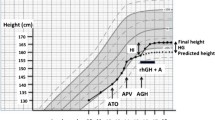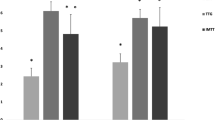Abstract
Data on the effects of recombinant human GH (hGH) therapy during male puberty on future testis function are still inconclusive. The aim of this study was to investigate the long-term effects of recombinant hGH treatment on reproductive function in non-GH-deficient short stature boys. Eight boys with non-GH-deficient short stature, affected by constitutional delay of puberty or idiopathic short stature, were retrospectively studied after recombinant-hGH treatment to verify gonadal development, hormone production and semen quality. Auxological data, endocrinological/andrological parameters and laboratory evaluation (GH, IGF-I, FSH, LH, testosterone, inhibin B) were assessed before treatment; after completion of pubertal development, the same parameters plus SHBG levels were evaluated and a seminal fluid examination was conducted (ejaculate volume, pH, sperm concentration, total sperm count, forward and total motility, morphology). All patients showed normal testicular volume at the final pubertal stage, with regular androgenisation. Hormonal levels were within the normal adult range in all boys. Considering the immature reproductive system of these patients in comparison with adults, semen parameters (sperm count, motility, and morphology) were within almost normal limits, except in one patient. Although patients showed the wide fluctuation of semen values frequently observed at the end of puberty, the hypophysis-gonadal axis hormones were in the normal range in all adolescents. Pathological measurements of some seminal parameters were found in one patient only. This study suggests that recombinant hGH treatment has no detrimental effects on the development and maturation of male gonadal function in non-GH deficient short stature young patients.
Similar content being viewed by others
References
Illig R, Prader A. Effect of testosterone on growth hormone secretion in patients with anorchia and delayed puberty. J Clin Endocrinol Metab 1970, 30: 615–8.
Link K, Blizzard RM, Evans WS, Kaiser DL, Parker MW, Rogol AD. The effect of androgens on the pulsatile release and the twenty-four-hour mean concentration of growth hormone in peripubertal males. J Clin Endocrinol Metab 1986, 62: 159–64.
Liu L, Merriam GR, Sherins RJ. Chronic sex steroid exposure increases mean plasma growth hormone concentration and pulse amplitude in men with isolated hypogonadotropic hypogonadism. J Clin Endocrinol Metab 1987, 64: 651–6.
Ulloa-Aguirre A, Blizzard RM, Garcia-Rubi E, et al. Testosterone and oxandrololone, a nonaromatizable androgen, specifically amplify the mass and rate of growth hormone (GH) secreted per burst without altering GH secretory burst duration or frequency or the GH half-life. J Clin Endocrinol Metab 1990, 71: 846–54.
Radicioni A, Paris E, Dondero F, Bonifacio V, Isidori A. Recombinant-growth hormone (rec-hGH) therapy in infertile men with idiopathic oligozoospermia. Acta Eur Fertil 1994, 25: 311–7.
Carani C, Mantovani R, Procopio M, Del Rio G, Rossetto R, Granata AR. GH/IGF-I axis in azoospermia in primary and secondary hypogonadism: a study before and during replacement therapy. Int J Androl 1999, 22: 184–9.
Wilson TA, Rose SR, Cohen P, et al. Update of guidelines for the use of growth hormone in children: The Lawson Wilkins Pediatric Endocrinology Society Drug and Therapeutics Committee. J Pediatr 2003, 143: 415–21.
Frish H. Clinical review of pediatric indications for treatment with growth hormone. In: Ranke MB ed. Growth hormone over the human life span. Heidelberg-Leipzig: JA Barth Verlag 1998, 8–24.
Bertelloni S, Baroncelli GI, Viacava P, Massimetti M, Simi P, Saggese G. Can growth hormone treatment in boys without growth hormone deficiency impair testicular function? J Pediatr 1999, 135: 367–70.
Leschek EW, Troendle JF, Yanovski JA, et al. Effect of growth hormone treatment on testicular function, puberty, and adrenarche in boys with non-growth hormone-deficient short stature: A randomized, double-blind, placebo-controlled trial. J Pediatr 2001, 138: 406–10.
Ankarberg-Lindgren C, Norjavaara E, Wikland KA. Short boys treated with growth hormone show normal progression of testicular size and achieve normal serum testosterone concentrations. Eur J Endocrinol 2002, 146: 681–5.
Hokken-Koelega A, van Pareren Y, Arends N, Boonstra V. Efficacy and Safety of Long-Term Continuous Growth Hormone Treatment of Children Born Small for Gestational Age. Horm Res 2004, 62(Suppl 3): 149–54.
Radicioni AF, Anzuini A, De Marco E, Nofroni I, Castracane, VD, Lenzi A. Changes in serum inhibin B during normal male puberty. Eur J Endocrinol 2005, 152: 403–9.
Greulich WW, Pyle SI. Radiographic atlas of skeletal development of the hand and wrist. 2nd ed. Stanford, CA: Stanford University Press. 1959.
Tanner JM. Growth at adolescence. Oxford, UK: Blackwell Science. 1962.
Zachmann M, Prader A, Kind HP, Haflinger H. Testicular volume during adolescence. Cross-sectional and longitudinal studies. Helv Paediatr Acta 1974, 29: 61–72.
Mathur RS, Moody LO, Landgrebe S, Williamson HO. Plasma androgens and sex hormone binding globulin in the evaluation of hirsute females. Fertil Steril 1981, 35: 29–35.
World Health Organization. WHO Laboratory Manual for the Examination of Human Semen and Sperm-Cervical Mucus Interaction. 4th ed. Cambridge, UK: Cambridge University Press, 1992.
World Health Organization. WHO Laboratory Manual for the Examination of Human Semen and Sperm-Cervical Mucus Interaction. 5th ed. Cambridge, UK: Cambridge University Press, 1999.
Gandini L, Lombardo F, Paoli D, et al. Full-term pregnancies achieved with ICSI despite high levels of sperm chromatin damage. Hum Reprod 2004, 19: 1409–17.
Hindmarsh PC, Brook CGD. Final height of short normal children treated with growth hormone. Lancet 1996, 348: 13–6.
Kawai M, Momoi T, Yorifuji T, Yamanaka C, Sasaki H, Furusho K. Unfavorable effects of growth hormone therapy on the final height of boys with short stature not caused by growth hormone deficiency. J Pediatr 1997, 130: 205–9.
Hopwood NJ, Hintz RL, Gertner JM, et al. Growth response of children with non-growth-hormone deficiency and marked short stature during three years of growth hormone therapy. J Pediatr 1993, 123: 215–22.
Loche S, Cambiaso P, Setzu S, et al. Final height after growth hormone therapy in non-growth-hormone-deficient children with short stature. J Pediatr 1994, 125: 196–200.
Paris E, Menchetti A, De Lazzaro E, Marrocco M, Nuzzo C, Radicioni A. The spermiogram in adolescence. Minerva Pediatr 1998, 50: 303.
Andersson AM, Skakkebæk NE. Serum inhibin levels during male childhood and puberty. Mol Cell Endocrinol 2001, 180: 103–7.
Author information
Authors and Affiliations
Corresponding author
Rights and permissions
About this article
Cite this article
Radicioni, A.F., Paris, E., De Marco, E. et al. Testicular function in boys previously treated with recombinant-human growth hormone for non-growth hormone-deficient short stature. J Endocrinol Invest 30, 931–936 (2007). https://doi.org/10.1007/BF03349240
Accepted:
Published:
Issue Date:
DOI: https://doi.org/10.1007/BF03349240




